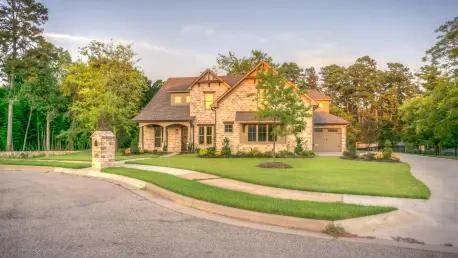In today’s competitive real estate market, homeowners are searching for ways to make their properties stand out without draining their wallets. Enhancing a home’s curb appeal is a strategic approach that can make a significant difference in its attractiveness. With the right changes, a property’s exterior can transform dramatically, becoming more inviting not only for potential buyers but also for the residents. The focus should be on accessible and affordable updates that can generate substantial visual impact. This article explores various expert suggestions on how to elevate curb appeal by making small, cost-effective modifications. From the addition of vintage garden sculptures to the choice of a fresh coat of paint, these methods are designed to bring out the best in any home’s facade, offering lasting beauty and increased property value.
Strategic Use of Materials
One of the most accessible ways to enhance curb appeal involves strategic material choices that offer both durability and aesthetic value. Vintage garden sculptures, for example, offer an elegant addition to front yards and can typically be found in flea markets or garage sales at a fraction of retail prices. Stone and concrete are also recommended materials due to their enduring nature through various weather conditions while adding a timeless and antiquated charm to the landscape. Whether it’s through new pathways, patios, or decorative stone arrangements, these materials ensure both functionality and visual interest. Experts like Anu Kurup from Persimmon Design highlight that using such elements can add substantial character to a home’s exterior while maintaining a natural look that ages beautifully over time.
Another valuable consideration is the transformative effect of paint. A fresh coat of paint can rejuvenate any exterior surface, be it walls, fences, or garden borders. By selecting nature-inspired neutrals or warm whites, homeowners can achieve a sophisticated look that stands the test of time. Darker shades such as green, slate, or brown can lend a stately appearance and contrast beautifully with lighter elements in the landscape. Balancing these colors harmoniously with the natural surroundings can create a cohesive aesthetic while staying within budget. Vince Stroop, known for his work in design, advocates for the power of paint, emphasizing how such simple updates are both impactful and economical.
Enhancing Focal Points and Plant Selections
Focusing on key elements of the home that naturally draw attention, such as the front door, can significantly heighten curb appeal. A bold door color can serve as a striking focal point, expressing the homeowner’s personality and taste. However, for those considering selling, opting for a more neutral door color may be wise to appeal to a broader audience. Both Vince Stroop and Tessa Kluetz Pernell recommend aligning door hues with the overall color scheme of the house to maintain balance and coherence. Such focal points can make a memorable first impression, underscoring the importance of thoughtful color selection in exterior design.
In terms of landscaping, plant selection plays a crucial role in maintaining an attractive exterior throughout the year. The versatility of garden design allows for adjustments that cater to varying budgets, enabling homeowners to create year-round interest. Seasonal and permanent plantings are effective in providing continuous visual appeal. Planning the purchase of plants based on color, size, and type ensures a harmonious and diverse garden. Mulching not only enhances the aesthetic quality but also promotes soil health, requiring only periodic maintenance. Tessa Kluetz Pernell advises careful planning when integrating plant life into the landscape to achieve a well-composed design that evolves with the seasons.
Lighting and Minor Upgrades
The thoughtful application of lighting can have an understated yet profound impact on curb appeal. Especially in regions with long gray winters, strategically placed lighting adds depth and ambiance to outdoor spaces. Portable solar lanterns and battery-powered lamps provide flexible solutions for patios and gardens, offering warmth and functionality. String lights draped over spaces contribute a whimsical quality, creating inviting atmospheres suitable for both relaxation and entertainment. Warm-white LED lighting ensures longevity and complements a variety of outdoor styles, bridging the gap between cozy indoor environments and alluring outdoor settings.
Minor upgrades can also make a substantial difference, reflecting a thoughtful update that can refine a home’s exterior style. Modernizing house numbers and mailboxes is a simple task that yields significant results. Choosing numbers that complement the overall design of the home while ensuring high visibility is essential for aesthetic and practical purposes. Meghan Price suggests that integrating these elements into the home’s architecture not only enhances visual appeal but also offers functional improvements, such as improved security. When executed with attention to design details, these updates considerably enhance the home’s welcoming appearance and overall charm.
Natural Elements and Four-Season Planters
Seamlessly integrating natural materials into the home’s design can elevate curb appeal while establishing harmony with the surrounding environment. This approach reflects a deep appreciation for nature’s beauty and durability. Reclaimed wood and stones are popular choices that introduce organic textures and forms into outdoor settings. When used for garden borders, seating areas, or decorative features, these materials enrich the landscape with warm, inviting qualities. All-weather wicker furniture or resin-wrapped furniture pieces can soften rigid spaces, adding comfort to outdoor seating areas that encourage relaxation and social interaction.
Most importantly, the use of four-season planters ensures that a garden remains attractive throughout the year. By creatively combining compact evergreens with seasonal flowers and colorful foliage, homeowners can achieve a vibrant and dynamic outdoor space. Proper planter choice is key, with frost-resistant materials and adequate drainage essential for protecting plants and decking surfaces. Such planters provide a visual link between the interiors and gardens, enhancing harmony and flow, while reflecting the homeowner’s dedication to style and innovation.
Final Considerations
One practical approach to boosting curb appeal is through careful selection of durable and visually appealing materials. Vintage garden sculptures, particularly, introduce elegance to front yards and can often be sourced from flea markets or garage sales at a fraction of retail costs. Stone and concrete are suggested materials due to their resilience in diverse climates, adding an enduring, classical charm to landscapes. Whether incorporated through pathways, patios, or decorative stone features, these materials deliver both functionality and aesthetic appeal. According to Anu Kurup of Persimmon Design, such elements contribute substantial character to a home’s exterior while maintaining a natural look that matures gracefully.
Another important aspect is the transformative power of paint. A fresh paint coat can revitalize any exterior, like walls, fences, or garden edges. Opting for nature-inspired neutrals or warm whites gives a sophisticated appearance that lasts. Darker tones, such as green or slate, offer a refined contrast with lighter landscape elements. Harmonizing these colors with the natural setting achieves a cohesive aesthetic affordably. Vince Stroop, a design expert, endorses the cost-effective impact of paint in enhancing curb appeal.









